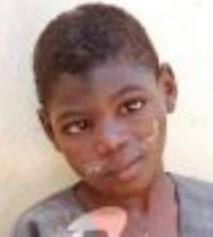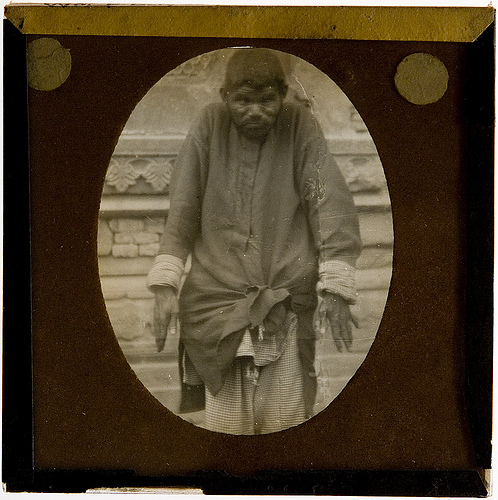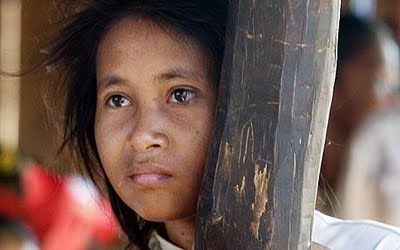Sir Francis Galton coined the term ‘nature vs. nurture’ over 150 years ago, exploring “whether heredity or the environment most impacts human psychological development (behavior, habits, intelligence, personality, sexuality, aggressive tendencies, and so on)” (cliffnotes.com). Those who believe in the nurture part think that humans learn according to how they are taught and what goes on around them. Those debating from the nature side say that we act according to genetic predispositions, as well as through animalistic instincts (i.e. Freud’s id).
What do you think? Are individuals a product of their environment, their genes, or a combination of both? Feral children are interesting aspects of this debate. A feral child is often defined as a young human being that is either abandoned or confined in some sort of situation that takes them away from any type of human interaction or communication. As a result, these children often lack social skills; even something as simple as speaking can be a skill they never learn. Many of these children are ‘raised’ by other means (usually animals). They simply learn from what they see around them, just as a child would under normal circumstances; it is what they learn that is very different.
Editor’s Note: Out of respect for the fact that these are actual people, some who are still alive today, we have listed them by their real names rather than the nicknames generated by the media.
10. Bello of Nigeria
Bello, sometimes referred to as the Nigerian Chimp Boy by the media, was found in 1996. No one is exactly sure of his age but many estimated that he was about 2 years old when he was discovered. He was found in the Nigerian forest and is both physically and mentally disabled, possibly the explanation for his abandonment at six months of age (a very common practice within the Fulani tribe). At such a young age, Bello of course could not fend for himself but somehow chimpanzees that lived within the forest took him in and raised him. He took on many chimpanzee behaviors, walking like them and displaying many of their animalistic behaviors.
When he was found in the Falgore forest, no one really mentioned the discovery. It wasn’t until about 2002 when popular news media found out and quickly learned that he was living in Tudun Maliki Torrey, a home for displaced children in Kano, South Africa. It was reported that he often disturbed other children within the home, throwing objects as well as jumping and leaping around at night. Six years later he was much calmer, though he still continued to display behaviors of a chimpanzee. Bello never did learn to speak despite the constant human interaction he had within the home, and in 2005 he died of undetermined causes.
9. Vanya Yudin
One of the more recent cases of a feral child is Vanya Yudin (referred to by news agencies as ‘the Russian Bird Boy’). It is said that when he was found by Russian caseworkers in 2008, he was 7 years old and unable to speak. He did nothing but chirp and flap his arms as if he had wings, and exhibited a lot of the behavior that you would expect from a bird. He was kept in a two-room apartment with bird cages filled with dozens of birds that were owned by his mother. Galina Volskaya, one of the social workers taking part in the case stated that even though the boy lived with his mother, she never spoke to him and she simply treated him like another one of her pets. When Volskaya attempted to talk to the boy, he didn’t speak, just chirped.
While he was never abused physically, the boy was still treated with similar methods to others on the list due to the lack of human interaction. He was put into an asylum where he received treatment to allow him to become more human-like. After, he was sent to a center for psychological care to further his journey to becoming more socially aware and accepted.
8. Dina Sanichar
Dina Sanichar, named ‘the Indian Wolf Boy,’ is one of the oldest known cases of a feral child. He was believed to be about 6 years old when he was found by hunters in 1867. The hunters saw a pack of wolves enter a cave followed by a human who was running on four legs. The men smoked the wolves out of the cave. The men then went into the cave and found Dina. He was rescued from the jungles of Bulandshahr and put through treatment, though not much existed during his time.
People worked with him to rid him of his animalistic behaviors, which included eating raw meat, ripping off clothing, and eating food that was on the ground. After time he was able to be fed cooked meat, but he never did learn to talk.
7. Rochom Pn’gieng
On January 23, 2007, a Cambodian woman (‘the Cambodian Jungle Girl’) came out of a jungle located in the Ratanakiri province of Cambodi after spending more than 19 years living in the jungle. A family in a close by village announced that the Cambodian woman was their daughter and that her name was Rochom Pn’gieng, a girl who had gone missing in 1979. When she was found she was naked and terrified. She was discovered after food from a lunchbox went missing and a man went on a hunt to find out who had taken it. The man gathered friends and found the woman in the jungle, captured her, and called police.
Coincidentally, it turned out that the head policeman was her father- he recognized a prominent scar on her back. At 8 years old, Rochom Pn’gien and her sister got lost in the jungle while herding buffalo (the sister has never been found). After she was discovered many worked with her to try to get her to adjust back to a normal lifestyle. When found she could say the words: stomachache, mother, and father. Her psychologist noted that she seemed to be speaking other words, but that they were unrecognizable. When she was hungry or thirsty she would simply point to her mouth. She also crawled more often than walk and refused to wear clothing. Despite being captured and treated, she has often tried (and sometimes succeeded) to escape back to the jungle.
6. Traian Caldarar
Another recent case of a feral child, Traian Caldarar (found in 2002) is often referred to as ‘the Romanian Dog Boy’ or ‘Mowgli,’ after the main character in the Jungle book. He had lived apart from his family for 3 years since the age of 4. When he was found at the age of 7 he was said to be the size of an average 3 year old due to a lack of proper nutrition. His mother was a victim of domestic violence who left her husband. It is believed that Traian also ran away from the home sometime afterwards. Traian lived in the wild and when he was found in 2002 in Brasov, Rom?nia. He found shelter in a cardboard box covered with a sheet. Traian had a severe case of rickets, poor circulation, and infected wounds. Because of his age, those who discovered Traian believed that stray dogs helped to keep him alive.
Traian was only found because a car belonging to a shepherd named Manolescu Ioan broke down and he had to walk through pastures, during which he spotted the boy. When he was found, the body of a dog was found nearby and many assume that he was eating the dog as a way to stay alive. Once he was taken into care, he would sleep under his bed instead of on it and would often want to eat. When he didn’t have food he became very irritable and often slept right after meals.
In 2007, it was reported that Traian was doing well under the care of his grandfather and in grade 3 at school. When asked about his school, he said “I like it here, coloring, play and learn to write and read. We have toys, cars, teddy bears, and the food is very good,” (translasted from Romanian newsite cancan.ro).
5. John Ssebunya
It is said that John Ssebunya, also known as ‘The Ugandan Monkey Boy,’ ran away from home when he was three years old after witnessing his father murder his mother. He fled to the Ugandan jungles where he was said to be taken care of by green African monkeys. In 1991 he was found hiding in a tree by a woman named Millie who was a local tribeswoman. After spotting him she went back to her village to alert the men who then went into the jungle to capture John. While they were eventually successful, John and the monkeys, which had become his protectors, fought back, throwing sticks to defend him. In the end he was captured and taken back the village.
Once back in the village he was cleaned up but his entire body was covered in hair called hypertrichosis, a condition that brings about excessive amounts of hair in places that there usually isn’t hair. Also since he was living in the wild he had contracted a case of intestinal worms that were said to be over half a meter long once they exited his body. He was full of injuries- mainly his knees from imitating how a monkey walks. He was then given to Paul and Molly Wasswa who ran an orphanage, and the two taught him how to speak, though many believe he knew how to talk before running away. Today he sings with the Pearl of Africa children’s choir and exhibits little to no animalistic behavior.
4. Kamala and Amala
The story of two young girls, Kamala and Amala, is one of the most famous cases of feral children. Kamala was 8 years old and Amala was said to be 1 ½ when they were found in 1920. Both girls had spent most of their lives abandoned and alone. The two were found in Midnapore, India in a wolves’ den. Despite being found together, those who investigated the case believe that the two were not sisters but were simply abandoned around the same time or taken by wolves. The girls were found after stories spread throughout the village of two “ghostly spirit figures” that were often seen with the wolves that lived in the Bengal jungle. The local villagers were scared of the said spirits and called in a Reverend, Joseph Singh, to get to the bottom of it all. To see what was really going on, Singh hid in a tree above the cave and waited. When he saw the wolves exit the cave he waited and then saw two hunched over figures peek their heads out of the cave. He wrote down what he saw, describing them as “hideous looking with foot and body like a human being.” He said that the girls ran on all fours and had no real traits of being human.
Singh eventually captured the girls, though he had no experience in rehabilitating them. The girls slept curled together, growled, tore off their clothing, ate nothing but raw meat, howled, and were physically deformed. The tendons and joints in their arms and legs shortened, making it impossible to walk upright. The two also had no interest in interacting with humans. Some say that their senses were impeccable, especially when it came to hearing and seeing, but even their sense of smell was sharp. Amala eventually died due to a sickness, which then caused Kamala to go into a long-stage of mourning. Singh thought she would die but she did not and he started a rehabilitation program to help heal her- she eventually learned to walk upright and say a few words. She died of kidney failure in 1929.
3. Victor of Aveyron
Victor ‘the Wild Boy of Aveyron’ is another name on the list that you may sound familiar. Some say that he could be the first documented cause of autism, but he is definitely a well known case of a child that was left alone in the wild. At the end of the 18th century, several people saw Victor wandering in the Saint Sernin sur Rance woods, which is located in southern France. Victor was captured a first time and somehow escaped. It wasn’t until January 8, 1800 that he was caught again after coming out of the woods on his own, though he was spotted several times in 1798 and 1799. At this time he was said to be about 12 years old. His body was covered in scars and he was unable to speak a word. He was taken back to town where he was generally accepted, though once the news spread, many came forward wanting to examine him.
A biology professor, Pierre Joseph Bonnaterre, decided to examine Victor, taking off his clothes and putting him outside in the snow. Victor began to run around in the snow, showing no ill-effects of the cold temperature on his bare skin. It is said that he lived in the wild for about 7 years, so it is no surprise that his body was able to take such extreme weather. Roch-Ambroise Cucurron Sicard then took over and decided to try to teach the boy, though he soon became frustrated at his lack of progress. Though he was probably born with the ability to talk and hear, he never did so properly after being left in the wild. He was eventually taken to the Paris Institution des Sourds-Muets where he lived with Mme Guérin and died at the age of 40.
2. Oxana Malaya
In 1991, Oxana Malaya, who lives in Ukraine, was found and considered to be a feral child. At the time she was found, she was only 8 years old and is said to have lived amongst dogs since she was 3 years old. She was kept in a kennel in the backyard of her home. Because of this she picked up common behaviors that dogs exhibit: barking, growling, and even protecting the pack, so to speak. She even walked on four legs as a dog does and sniffed out her food before she ate it. When authorities came to rescue Oxana, the other dogs growled and attempted to attack them while Oxana barked and growled as well. Because of her lack of human interaction, Oxana had no vocabulary except the words “yes” and “no.”
She was of course put through intensive therapy to attempt to help her to learn necessary social and verbal skills. She was able to learn how to speak, though therapists say she has deep issues with attempting to communicate and express herself emotionally. Today she lives at the Baraboy Clinic in Odessa and spends a lot of her time tending to the cows at the hospital’s farm, though she has expressed that she really feels best when she is around dogs.
1. Genie
If you ever take a Psychology class or get into a conversation about feral children, Genie’s name will probably come up. For 13 years she was locked inside a room and strapped to her potty chair, other times she was bound in a sleeping bag and put inside a crib. Her father, the one behind the abuse, would hit her with a stick if she ever spoke and he would bark and growl at her to keep her quiet. He also forbade his other children and even his wife from speaking. Because of this, Genie had a very small vocabulary, consisting of about 20 words. The phrases she did know included “stop it” and “no more.” She was discovered in 1970 and today she is considered to be one of the worst cases of social isolation known. She was often thought to be autistic until doctors found out she was really 13 and was a victim of abuse.
She was taken to Children’s Hospital Los Angeles where she was treated for years. After some treatment, she was able to answer questions in one-word answers and she learned how to dress herself. However, she still held onto her learned behavior, including a “bunny walk” where she held her hands up in front of her as if they were paws. She also scratched and even clawed at things. Though she was moved around a lot, she found home with her therapist David Rigler for 4 years, who worked with her daily. He and his family taught Genie sign language as well as ways to express herself without speaking; drawing was a method. Genie then went to live with her mother, and then abusive foster parents, which then caused her to become mute again and afraid to speak. Today she is living somewhere in Southern California.









No comments:
Post a Comment